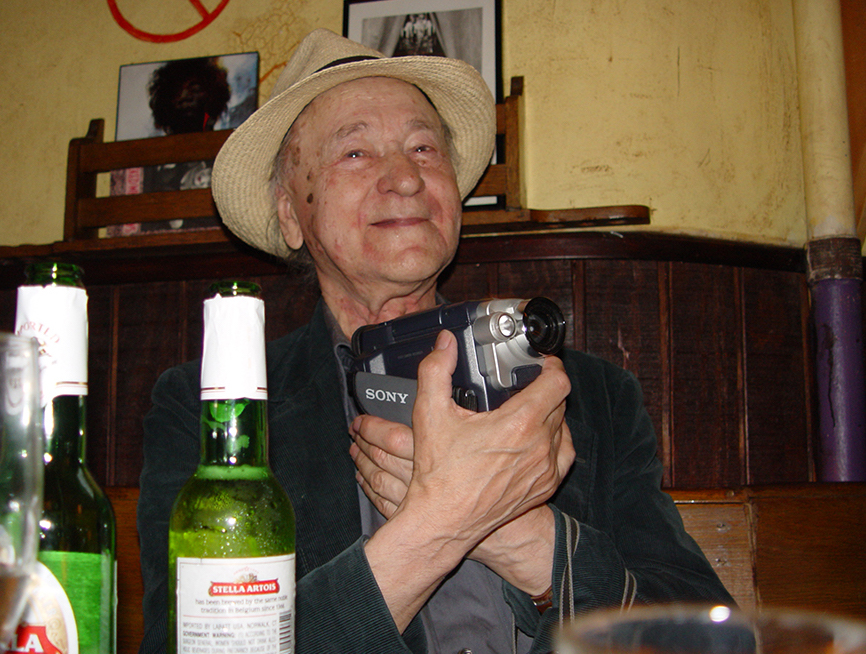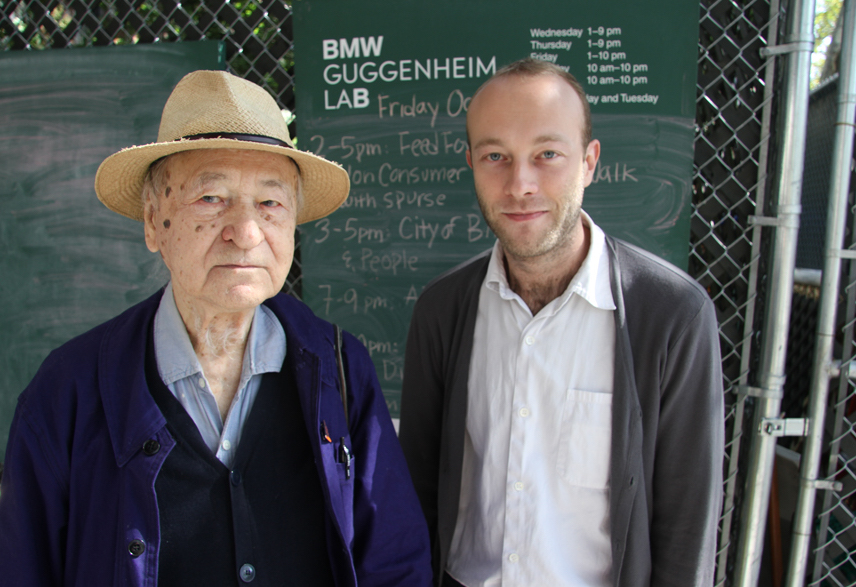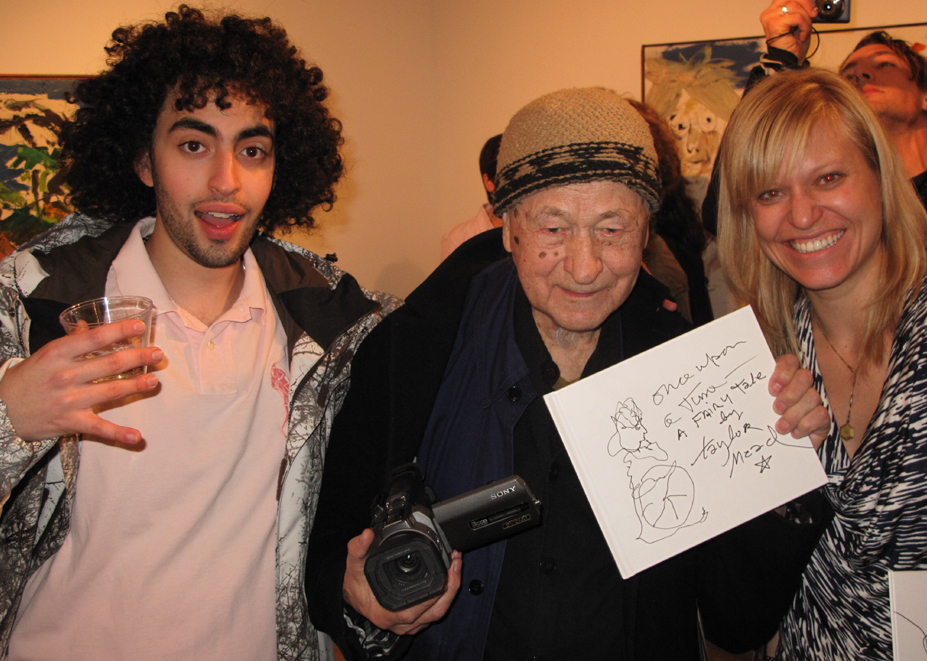
BY CARY ABRAMS | As the red state, blue state gulf widens, certain factors only serve to highlight this phenomenon. Jonas Mekas’s death on Wed., Jan. 23, might be one such event.
The New York Times printed a lengthy obituary in the paper the following day, which was expected, as Jonas was certainly deserving. At 96, Jonas’s death was not unexpected. He had been blessed by a lengthy life marked by myriad artistic accomplishments, active until his passing.
While his death looms large for many New Yorkers, especially film buffs, such as myself, I daresay, to most Americans, Jonas’s name and his face would draw a blank stare.
I heard Jonas had been ill of late. Yet, a friend reported seeing him energetically bounding up to the stage to speak at a recent event. Surely, the Times had his obit already written and awaiting his eventual death for publication. Unlike some of the relatively obscure figures the paper chooses to dredge up from the New York City underground scene, elevate with an obit, often a considerable time after their death, Jonas was a cultural force, a shaper of the city’s creative scene operating on several fronts.
His physical legacy is writ large in the Anthology Film Archives, located in the low-rise, red-brick, former city courthouse and jail on the corner of E. Second St. and Second Ave. The building houses the vast underground film collection he amassed, much of which he is responsible for preserving, restoring.
Mekas was prescient enough to salvage the building in 1979, after the city had closed the courthouse down. I remember attending parties there back in the early ’80s, when partygoers sat on the uncomfortable, hard-surfaced former prisoner beds still occupying the steel-barred cells.
As I ponder Jonas’s passing, the loss of his creative energy to the New York scene is immense. I am reminded of Allen Ginsberg’s passing in 1997, as the two, who were friends, both operated on a similarly high energy level. Each was a man about town, who might surprisingly appear at any event, whether Uptown or Downtown, high or low culture, know many in the room, mix easily, freely sharing their wit, candor, their genius.

I was fortunate enough to hear Jonas speak twice this past year, each appearance indicative of some aspect of his broad influence on New York culture. The first meeting was at a book publication event at 192 Books, a small bookshop over in the far west Chelsea gallery district in May. I was unfamiliar with the poet, Florbela Espanca, a Portuguese woman who had tragically died at 36 in 1930. I was drawn by the opportunity to hear work from a “new” voice.
The small store was overflowing with people, many chatting in Portuguese. I was surprised to see Jonas in attendance. I learned that he had been instrumental in the publication of the book.
Manuela Bairos, the consul general of Portugal, was one of several readers reciting Florbela’s poems, both in Portuguese and English. She described how Jonas had stressed to her the importance of publishing the book, which the New York Portuguese Consul eventually provided support for.
With each poem, I was drawn into the tragedy of this woman’s life, her suffering, her outpouring of emotion, the depth of her soul.
Jonas spoke eloquently, emotionally of how Sara Trindade had come to him with a translation of Florbela’s poems, and her need to have the book published. Jonas read the poems, was moved, accepted the challenge. For Jonas had proclaimed, “Only poets are free!” soon after his arrival as a displaced person in New York City soon after World War II.
I was moved, as well, as were many in the room, by the passion of the poems, and the fado dancer who performed. I purchased three copies of the book and had Jonas autograph them. I’ve given two of the copies to friends I believe worthy recipients. I hoped it would similarly impact them. They later related that it has.
In addition to learning of a forgotten poet, I was made aware of another aspect of Jonas’s being, his generosity, his dogged pursuit of his goals, his support of other artists.
My second recent Jonas encounter came at another book publication party, this one at Printed Matter, also in Chelsea, in September, for the publication of “Film Culture 80,” devoted to Barbara Rubin, a fairly obscure filmmaker who Jonas had befriended and mentored back in the early ’60s. Film Culture, a journal that dealt primarily with underground cinema, was begun by Jonas and his brother, Adolfas, in 1954, and continued through 1996, producing 79 issues.

Chuck Smith, a film director who had completed an award-winning documentary, “Barbara Rubin and the Exploding New York Underground,” last year, had approached Jonas with the idea of reviving the magazine for a volume on Barbara. Of course, Jonas accepted the challenge, graciously offered up letters, his memories, other items from his archive for the magazine.
Jonas figures prominently in the film. Again, Jonas spoke passionately, describing Barbara’s importance to the ’60s New York scene, and his influence on her in the production of her unheralded masterpiece “Christmas on Earth.”
When she left New York City in the early 1970s, abandoning her bohemian lifestyle, reinventing herself as an Orthodox Jew, she gave her film to Jonas, instructing him “to destroy it, or do whatever you see fit.” Of course, master archivist that he was, Jonas chose to preserve the film, so that we owe its continued existence to him. In addition, some of Barbara’s writings that are in “Film Culture 80” were preserved by Jonas.
Sections of Barbara’s film were recently shown as part of the Velvet Underground tribute exhibition that recently closed. I viewed Chuck’s film at the Documentary Film Festival held this fall at IFC, and would highly recommend it for a rare glimpse of Barbara, a truly unique individual, along with the ’60s New York scene of The Velvet Underground, Warhol, The Fugs, Dylan and Allen Ginsberg. Jonas’s insights were always pithy, to the point. He brought clarity to a subject.
When Jonas spoke at Printed Matter, he remembered Barbara, her filmmaking skills, the groundbreaking aspects of her work as a female cinematographer, her impact on the ’60s arts scene in the city. Jonas was passionate about Barbara, a woman he mentored, as he was about Florbela, a poet whom he had never met, but only knew through her poetry. Jonas’s passion filled a room, as he spoke in his still heavily accented voice.
A friend, an N.Y.U. English professor, Bryan Waterman, commented, “What I admire most about him is that he stayed on the scene and he never stopped working.” He described having bought three newly published books by Jonas in the past year.
At 96, long after many of his demographic had faded, Jonas was still high energy, inspiring others, young and old. His spirit was a palpable force at any event he attended. He was always gracious, open, accommodating, offering up inspiration, encouragement to other artists’ projects. Jonas was a presence. He will be missed.

















